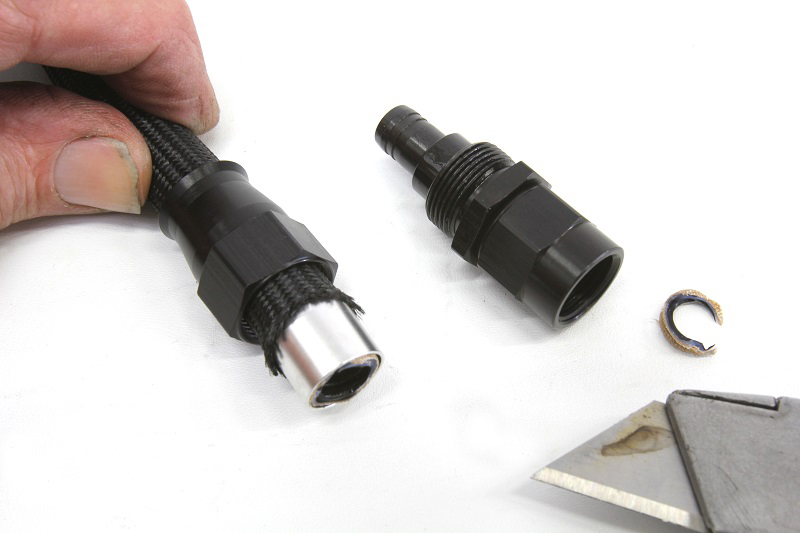
This is a pre-assembly photo of Holley Earl’s UltraPro fuel line and its specific 90-degree hose end. Note that we’ve already installed the ferrule over the PTFE liner. The instructions say to use a sharp razor knife to trim a small portion of the liner flush with the ferrule and then install the fitting into the socket and tighten. (Image/Jeff Smith)
I’m building an in-tank fuel pump for a fuel injection conversion in a ’69 Nova with a small-block. I have no experience running lines for relatively high pressure injection stuff. What’s the most painless and economical fuel supply line to build?
Is the braided line (PTFE?) with -6 AN fittings the way to go? I see kits that have a rubber line with what appears to be a crimp connection, similar to a PEX crimp perhaps? What would be your recommendation? — J.R.
There are several ways to go with building a fuel line these days so you have lots of options. It comes down to what you want to spend. The best line in my opinion is the latest stuff from Earl’s that is a convoluted PTFE fuel hose. The PTFE (polytetrafluoroethylene) is a Teflon®-like material impregnated with carbon that makes the inner liner a darker color, as opposed to the generic white PTFE. The addition of the carbon makes the material conductive so that there’s no chance of a static electricity discharge that can occur with non-carbon infused PTFE.
This material is the same as what is used in all new OE production cars as it is impervious to all fuels and additives. Plus, it offers a near perfect vapor barrier so that there’s no evaporation through the fuel line. This is especially important to the OEs, as there are specific shed tests where the car must not emit vapors. That’s why your home garage doesn’t smell like gasoline like it used to with older cars that had fuel tanks which vented to the atmosphere.
This convoluted PTFE hose – called UltraPro – while really good also demands its own specific fittings. These fittings use a sealing ferrule and require a very specific assembly procedure. It’s not difficult, but is different than normal AN hose.
As you might expect, this UltraPro hose is expensive. Through Summit Racing, a 20-foot length of 3/8-inch (-6 AN) Ultra-Pro hose runs over $180 and a 90-degree fitting is around $25. This technology isn’t cheap, but it appears that, short of physical damage, this fuel line and the fittings will last the life of your vehicle.
Other companies that make the PTFE hose include TechAFX, which is also a carbon-impregnated PTFE hose but this is not convoluted. Because of the stiffer nature of PTFE, this non- convoluted line requires a larger bend radius than the convoluted material. Like the UltraPro, this SS braided hose also requires specific fittings that use a ferrule to seal to the fitting.
A much more affordable Earl’s piece is called the Vapor Guard hose. This is a multi-layer rubber exterior hose that offers protection against all the aromatic additives as well as a vapor barrier that prevents fuel from evaporating through the hose. Earl’s is not specific as to exactly what the inner liner material is but it does not appear to be PTFE. The good news is that this hose and fittings are significantly less expensive. The fittings are simple slip-on barbed pieces that use an upscale hose clamp to seal. The Vapor Guard hose comes in both carbureted and EFI-specific hoses. The EFI hose is designed to withstand 225 psi maximum fuel pressure while the carb-only hose is rated to 50 psi and should not be used in even 43 psi EFI applications.
Keep in mind that this Vapor Guard hose will probably not weather extreme heat or long-term use as well as the PTFE-style hose. But if you’re looking at trying to keep a lid on expenses, it’s not a bad way to go. Be aware however that NHRA drag strip tech rules limit the use of non-covered rubber fuel hose to under 12 inches of total length on the car. So if you’re planning on running your car at the drag strip, some kind of covered hose – even the basic braided stainless steel with a rubber lining – is acceptable, while the Vapor Guard hose will probably not pass tech.
Custom Fuel Line Hose Parts List:
Earl’s 3/8” Vapor Guard hose, 20 ft.
Earl’s straight -6 AN hose end, 3/8” barb
Earl’s 90-degree -6 AN, 3/8” barb
Earl’s 45-degree -6 AN, 3/8” barb
Earl’s -6 UltraPro convo PTFE hose, 20 ft.
Earl’s straight -6 UltraPro hose end
Earl’s 90-deg. -6 UltraPro hose end

Where can I find guidance on tools and procedures on how to actually do the work? I have an old Cougar with EFI that somebody else installed, and line that leaks at the fittings near the tank. I want to fix it myself with new line and fittings, since I don’t trust the shop that did the work.
This video shows 4 different types of fittings and hoses and how to install them. https://youtu.be/QFJ2ilmT5Lw
Hope this helps you.
Hey Jeff,
I have a 1994 Chevy Suburban C1500 5.7L V8 Silverado Base. I’m in the process of repairing/replacing the gas tank & fuel lines on this truck. My issues that I’m having is in regards to the fuel filler neck & fuel vapor hose that connects from the tank to the filler housing. Is there any company that can duplicate these parts seeing GM has discontinued the sale of them. Here’s the OEM part numbers listed with GM: Fuel Filler Hose 15644293 Fuel Vapor Hose 15644259. Thanks in advance for any info that you have and willing to share with me. Happy Holidays.
If you didn’t fancy making more hoses up in the future, we have an online hose builder for custom an hoses: https://www.customhoses.co.uk/hoses/oil-fuel-coolant, 100% made to measure, both PTFE and rubber inners.